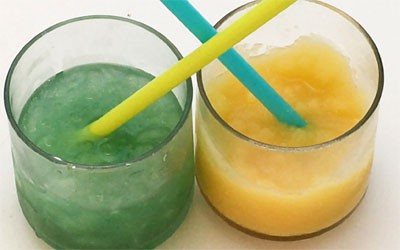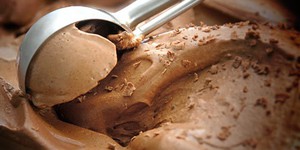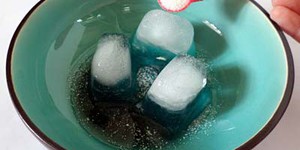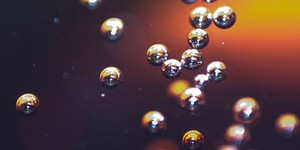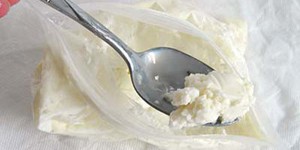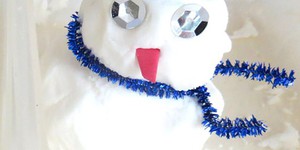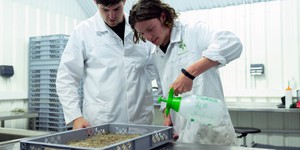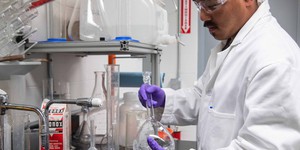Summary
Introduction
Do you enjoy ice-cold drinks? A slushy is about as close as you can get to liquid ice: colder than water, but more drinkable than ice! Using some common household items, a little bit of patience, and the help of science, you can make this delicious, sweet drink at home. Try the activity, and you will be rewarded with a delightful treat!
Materials
- Water
- Table salt
- Measuring cups
- Small mixing bowl
- Four zipper-lock sandwich bags
- Freezer
- Gloves or a towel
- Two smoothie shakers or 32 oz. food containers with lid, preferably translucent or transparent.
- Fruit juice, e.g. orange, apple, or grape juice. Do not use a light version.
- Optional: Food coloring
- Optional: Thermometer that can go to -12°C or 10°F
- Optional: Soda or fruit-flavored syrup.
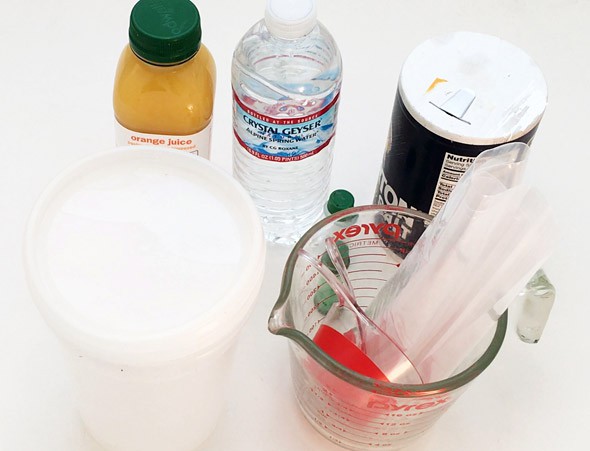 Image Credit: Sabine De Brabandere, Science Buddies / Science Buddies
Image Credit: Sabine De Brabandere, Science Buddies / Science Buddies
Prep Work
- In the following steps, you will make a special kind of ice, which you will then use to turn a liquid into slush.
- Pour half a cup of water into a bowl. Add one teaspoon of salt and stir until the salt is dissolved. If you have food coloring, you can mix in one or two drops. This will give your special ice a nice color and makes it easier to detect leaked salt water solution in your slushy.
- Pour the contents in a zipper-lock bag. Close the bag and set it aside.
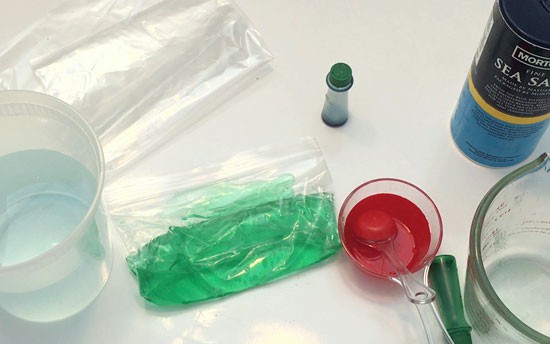 Image Credit: Sabine De Brabandere, Science Buddies / Science Buddies
Image Credit: Sabine De Brabandere, Science Buddies / Science Buddies
- Repeat the steps 2–3 three more times until you have four zipper-lock bags of salt water solution.
- Store the bags for at least five hours or overnight in the freezer. Make sure the bags do not touch each other so they do not freeze together.
- Store at least one cup of juice and water in the refrigerator.
Instructions
- Check if the four salt water solution bags in the freezer are frozen. If not, wait a few hours longer before proceeding.
- Take the frozen bags of salt water solution from the freezer using gloves or a towel to protect your hands. For each bag, open the zipper, push the air from the bags, and close the zipper again.
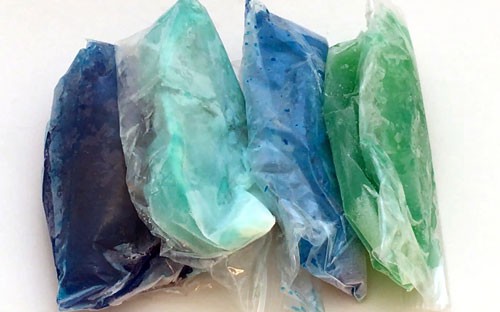 Image Credit: Sabine De Brabandere, Science Buddies / Science Buddies
Image Credit: Sabine De Brabandere, Science Buddies / Science Buddies
- Touch the bag with ice briefly with your fingers. If you have a thermometer, measure how cold this ice is. Ice cubes made of pure water are 0°C or 32°F.Does this ice feel colder than regular ice cubes? Did the thermometer confirm what you felt? Why would you need this special ice to prepare a slushy?
- Gather all the materials for the activity: juice and water at refrigerator temperature, the four bags of special ice, two shaker or food containers and a measuring cup.
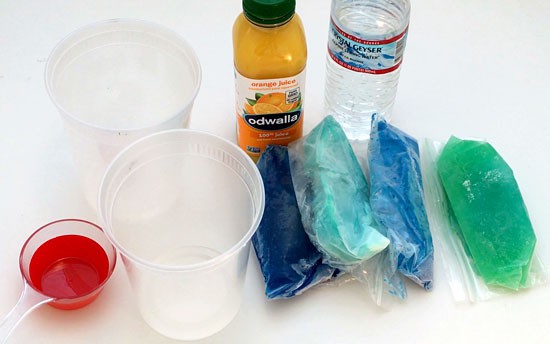 Image Credit: Sabine De Brabandere, Science Buddies / Science Buddies
Image Credit: Sabine De Brabandere, Science Buddies / Science Buddies
- Pour one cup of juice in a food container. Rinse the measuring cup and pour one cup of water in the other shaker or food container.
- Put two of the sealed zipper-lock bags with frozen salt water solution into each container before closing the lid.
- Shake one container a couple of times. Look through the sides of the container. Repeat with the other container.How do the liquids drip down from the sides of the container?
- Place your containers down and count slowly to 20 before repeating the previous step. Do this for several minutes.Does the way the liquids drip from the sides of the containers change? Why would this happen? Does it happen at the same time in both containers?
- Open the container after about three minutes.Do you see hints of slush? Do you see a similar amount in both containers?
- Close the containers and continue shaking intermittently.
- Once you see a thick mass sliding down the sides of a container, open the container again and look inside.Do you have a slushy? How did the special ice in the bags change? Why would it have changed?
- If the special bag of ice still has solid pieces of ice inside, you can close the container and continue shaking intermittently to make a denser slushy.Why might it not be a good idea to continue if the special ice is melted?
- If the special ice is melted, take out the bags of salt water and set them aside. If saltwater has leaked in your slushy, disregard the slushy, freeze the zipper-lock bags with salt water solution after rinsing them and try again.
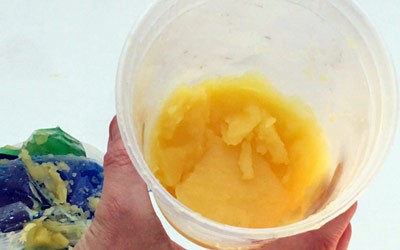 Image Credit: Sabine De Brabandere, Science Buddies / Science Buddies
Image Credit: Sabine De Brabandere, Science Buddies / Science Buddies
- There is a possibility that the juice never turned into a slushy. If your juice did not freeze, refreeze the zipper-lock bags with salt water solution after rinsing the outside and dissolving an additional ½ teaspoon of salt in each.Why do you think your juice did not turn into a slushy? Do you think you can solve the problem by adding more salt to the salt water solution in the bags? Why or why not?
- Pour the slushy content into a glass. If you have diluted syrup or soda, pour some over the slushy made with just water, mix well, and drink. Drink your juice slushy as is.Is one slushy better than the other?
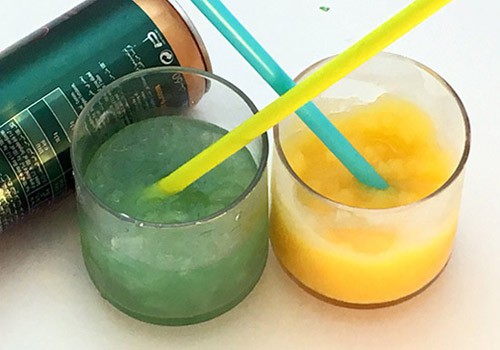 Image Credit: Sabine De Brabandere, Science Buddies / Science Buddies
Image Credit: Sabine De Brabandere, Science Buddies / Science Buddies
Cleanup
What Happened?
Did water turn into slush faster than juice? This is expected! Juice freezes at a lower temperature compared to water, so it needs to cool over a longer period before ice crystals appear.
Pure water freezes at 0°C (32°F). Dissolving particles in water makes it freeze at a lower temperature. That is why the salt water solution you made in this activity felt so cold when you took it out of the freezer. While making the slushy, it absorbed heat from the liquids in the containers. This process melted the salt water ice and cooled the liquids.
Fruit juice is made of fruit sugars dissolved in water together with some other particles like vitamins and minerals. As fruit juice contains pure water with particles dissolved in it, it freezes at a lower temperature than pure water. Most often, its freezing point is not as low as that of the salt water you created, so the frozen salt water could still freeze the juice, but it did so more slowly than it could freeze water.
Digging Deeper
A slushy is a dense, ice-cold beverage that resembles the thickness of melting snow.
Slushies can be made in two ways: you can flavor finely crushed ice, or you can alter the freezing process of flavored water so that loose, icy crystals form. Shaking the liquid while keeping it at the freezing point does just that.
The freezing point of a substance is the temperature at which the substance changes from a liquid to a solid. For pure water (H2O), this is 0°C or 32°F. At this temperature, water particles start to stick together and form a lattice or a crystalline hard structure.
Dissolving salt in pure water lowers its freezing point. This happens because the salt particles are in the way, making it harder for the water particles to stick together. This phenomenon is called freezing point depression. Salt is not the only substance that lowers the freezing point of water, but it is a very effective one that is commonly available. Dissolving other particles like sugar has a similar but smaller effect. In general, the more particles that are floating around in a fixed volume of water, the lower its freezing point will be.
Ask an Expert
For Further Exploration
- Find out if it is easier to first mix syrup in with the water and make a slushy of the mixture, or to mix in the syrup after you have created slush from the water alone. Why would this be the case? Which way tastes best?
- Try other juices. Which juice is easiest to transform into a slushy?
- Find ways to make a larger slushy.
- Find out what happens if you mix more salt into the water to create the special ice. What is the coldest special ice you can make?
- Test and see what happens if you do not shake the containers while making the slush.
Related Resources
Project Ideas
Activities
Links
- Blog Post: Bubbly Soda Science: Weekly Science Activity


